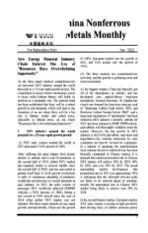State Grid Plans to Invest RMB403.5 Billion in 2014, Benefiting Non-ferrous Materials
2014-08-15
After four to five quiet years, the State Grid will accelerate its grid investment in 2014 with an increase rate close to 20% for the first time. Analysts believe that major investment in grid equipment will be made in 2014, which is also good news for nonferrous material enterprises.
The reporter learns that the State Grid recently held its working conference for 2014. It is planned that RMB403.5 billion will be invested in fixed assets, with RMB381.5 billion in power grid.
In 2013, the State Grid planned to invest RMB 318.2 billion in power grid, while actual investment was RMB 337.9 billion. Therefore, the investment in power grid in 2014 will drastically go up by almost 20% compared with the plan of last year, and 13% over the actual investment of last year. Since 2009, the annual investment increase of the State Grid has been 1% - 4%. In 2012, the investment plan was RMB 307.9 billion, but the actual investment was only RMB 305.4 billion. No wonder the investment plan for 2014 goes beyond market expectation.
An industrial source noted that the State Grid’s plan in investing RMB 403.5 billion in fixed assets with RMB381.5 billion in power grid demonstrates the determination and confidence of the State Grid in the power grid construction in 2014. This investment size well exceeds market expectation and represents good news for the power grid equipment segment.
With respect to extra-high voltage (EHV) and key project construction, the State Grid has expressed its intention to urge an official reply on the grid development plan, facilitate the improvement in the power grid project evaluation mechanism, and spare no efforts in overcoming the EHV development constraints. Meanwhile, the State Grid will incorporate EHV AC projects of Huainan-Nanjing-Shanghai, Ximeng-Zuanzhuang, Mengxi-Southern Tianjin and Jingbian-Weifang into the national air pollution prevention and control action plan, and will make efforts to get the “six AC four DC” EHV project approved and started within 2014.
A security analyst who declined to be revealed thinks that as the National Energy Administration has already included Ximeng-Zuanzhuang and Mengxi-Southern Tianjin into the pollution control measures for northern China explicitly in documents, it is highly likely that these two lines will be approved.
In terms of AC lines of above 66/110 KV, 59,000 KM was constructed in 2013 and 48,000 KM has been put into operation; and for 2014, the State Grid plans to construct 61,000 KM and put 51,000 KM into operation.
Director of the Energy and Economics Research Center of Xiamen University Lin Boqiang also told the reporter that although projects approved would normally less than those planned by the State Grid, the national campaign to curb fog and haze provides an extremely favorable opportunity for the approval of projects.
In addition, investment in construction and transformation of the distribution network in 2014 will reach RMB158 billion. The construction and transformation of the distribution network in the core areas of 30 key cities will be completed, focusing on improving power supply reliability and resolving the issue of low voltage in power supply in the rural area, and driving the construction of distribution network automation system in an orderly manner.
The above-mentioned security analyst said that the planned power grid investment increment mainly comes from the distribution network. With the subsequent release of power distribution automation standard and the launch of central bidding, the distribution network automation will go through major development.
The State Grid also mentioned that it will speed up the construction of the national unified electricity market, where it will not control both ends but will just supervise the middle part, selling electricity by bidding at the power generation end and buying electricity by bidding at the power consumption end.
At the end of October last year, the “383 Plan” published by the National Research Center also expressly recommended “power bidding” to form a competitive electricity market supported by the bilateral contract market and supplemented by the real time competition market, and to promote the reform of the electricity pricing mechanism. However, Li Boqiang thinks that even with such recommendations, it is difficult to make breakthroughs in the electricity system reform in the short term.
杂志排行
China Nonferrous Metals Monthly的其它文章
- It is Imperative for Chinese Enterprises to Change their Investment Model in Overseas Mining Industry
- Tibet’s Duolong Is Expected to Become a World-class Copper-Gold Mining Base
- The Ministry of Land and Resources Published the “Three-Rate” Indicator for Seven Minerals Including Iron Ore and Copper
- The Country’s New Policy Represents a Major Challenge for Lead Enterprises in Henan
- Chifeng to Build RMB200 Billion Nonferrous Metals Club
- Export Volume Increases While Price Drops: Three Major Factors Weakens Our Country’s Rare Earth Industry
